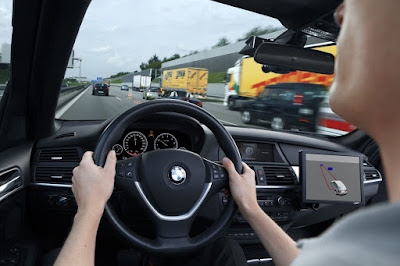1) Adjust the seat so that your feet comfortably reach both pedals. You can adjust your seat forward and backward, as well as up and down. Some cars will have electronic controls while older cars will usually have a latch underneath the seat that let's you control the position of the seat. But you can tell the difference.
2) Familiarize yourself with the foot pedals. In an automatic car, the two foot pedals control acceleration and braking, respectively. The rightmost pedal (which is usually smaller than the other pedal) is the acceleration pedal, and pressing down on it speeds the car up. The pedal to the left (which is usually larger than the acceleration pedal) is the brake pedal, and pressing down on it slows the car down.
- Even if you are left-foot dominant, use your right foot to reach both pedals. It will feel weird at first if you're left-footed, but getting used to it is important because it's proper technique and ultimately safer.
- Never use both feet at once to reach the pedals. Only use one foot — your right foot — to access each pedal. This will make it impossible to accidentally press down on both pedals at the same time.
3) Adjust your car's mirrors so that you can see through them clearly and effectively. Your car should have three mirrors: one rear view mirror, which allows you to see directly behind the rear windshield in back of you, and two outside mirror which let you see to either side of the car and protect you from blind spots.
- Your rear view mirror should be positioned so that when you're in your normal driving position, you can see directly behind you and as much of the rear windshield as possible.
- The Society of Automotive Engineers has one recommendation for how to position your outside mirrors in order to eliminate blind spots. It recommends positioning the mirrors further outward than normal, so that they just overlap with the viewing angle of the rear view mirror.[2] Although disorienting at first, this positioning actually clues the driver in to cars in her blind spots which she might otherwise only be able to spot by looking over her shoulder.
4) Know where the parking brake, also called a hand or emergency brake, is and what it does. The parking brake is a longer lever with a button on its very tip. When the parking brake is pulled up, it helps locks the car in place, ensuring that it doesn't move. When the brake is let down, it is disengaged and the car can freely move. Make sure that your parking brake is disengaged before you start driving.
5) Get a feel for the shift lever. The shift lever is usually positioned in between the two front seats of a car, and it controls some of the car's gears (park, neutral, drive, reverse). Sometimes, the shift lever is on the right side of the steering wheel.
- If your shift lever is engaged in Park and you turn your car on, your car won't move forward no matter how much you press down on the acceleration.
- If your shift lever is in Neutral, your car's natural momentum will continue to carry it forward.
- If your shift lever is in Reverse, your car will move backwards instead of moving forwards when you take your foot off the brake.
- If your shift lever is in Drive, your car will move forwards when you take your foot off the brake.6
6) Understand your basic dashboard controls. These gauges help show the driver how much gas the car is carrying, how fast the car is going, how hot the engine is, and how many RPM (revolutions per minute) the engine is clocking.
- The speedometer is probably the most important dashboard control in the car. It tells you how fast your car is traveling, in either miles per hour (MPH) or kilometers per hour.
- The RPM gauge tells you how hard your engine is working. Most RPM gauges will have red areas starting at 6,000 or 7,000 RPM. When the dial in the gauge, travels into the red, learn to ease off the acceleration.
- The gas gauge tells you how much fuel your car has. It usually has a dial that travels between "F" and "E," with "E" signaling "empty" and "F" signaling "full."

No comments:
Post a Comment